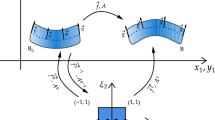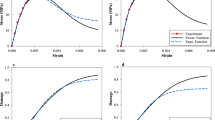Abstract
The principles for control of cracking in concrete structures due to imposed strain are investigated in this paper. The effects of uniform and non-uniform cooling and shrinkage are studied in medium-thick walls with regard to the amount of reinforcement necessary to distribute cracks. The influence of reinforcement on the behavior after the first crack is investigated, in particular its ability to reduce crack widths. The restraint force is significantly reduced for non-uniformly distributed imposed strain due to softening and cracking in the concrete. The amount of minimum reinforcement needed to distribute cracks is therefore significantly smaller for imposed strain in the form of drying shrinkage than for thermal imposed strain. Crack reinforcement is most effective for structures with large dimensions in the direction of external restraint.
Résumé
Cet article traite des principes pour le contrôle de la fissuration due à la déformation imposée dans des ouvrages en béton. Les effets du refroidissement uniforme et non uniforme, ainsi que le retrait, sont étudiés sur des murs d'épaisseur moyenne pour déterminer la quantité d'armatures nécessaires pour distribuer les fissures. L'influence de l'armature sur le comportement après la première fissuration est étudiée, et en particulier sa capacité à réduire la largeur des fissures. La force de rétreint est réduite de manière significative pour des déformations imposées qui ne sont pas uniformément distribuées en raison du radoucissement et de la fissuration du béton. La quantité minimale d'armatures nécessaires pour distribuer les fissures est donc nettement inférieure dans le cas de la déformation imposée sous forme de retrait de séchage, que dans le cas de la déformation imposée thermique. L'armature pour le contrôle de la fissuration s'avère être le plus efficace pour des ouvrages ayant des grandes dimensions dans le sens du rétreint externe.
Similar content being viewed by others

References
CEB, ‘Design Manual on Cracking and Deformations’, No 158, 1985.
Jaccoud, J. P., ‘Armature minimale pour le contrôle de la fissuration des structures en béton’, École Polytechnique Fédérale de Lausanne, Thèse No 666, 1987.
Falkner, H., ‘Zur Frage der Rißbildung durch Eigen- und Zwängspannungen infolge Temperatur in Stahlbetonbauteilen’, Deutscher Ausschuss Für Stahlbeton, Heft 208, Berlin 1969.
Helmus, M., ‘Mindestbewehrung zwangbeanspruchter dicker Stahlbetonbauteile’, Deutscher Ausschuss Für Stahlbeton, Heft 412, Berlin 1990.
Nagy, A., ‘Thermally induced softening and cracking in concrete with minimal reinforcement’,Mater. Struct. 30 (203) (1997) 527–532.
Thelandersson, S., Martensson, A., Dahlblom, O., ‘Tension softening and cracking in drying concrete’,21 (1988) 416–424.
Dahlblom, O., ‘HACON-T—A Program for Simulation of Temperature in Hardening Concrete’, Vattenfall (Swedish State Power Board) R,D&D. U 1990/31.ISSN 1100-5130.
Hillerborg, A., ‘Kompendium i byggnadsmateriallära, FK1’, Div. of Build. Mat. Lund Institute of Technology, Sweden, 1975.
Hillerborg, A., ‘A Model for Fracture Analysis’, Report TVBM-3005,, 1978.
Gustafsson, P.J., ‘Fracture Mechanics Studies of Non-Yielding Materials Like Concrete: Modelling of Tensile Fracture and Applied Strength Analysis’, Report TVBM-1007,, 1985.
Author information
Authors and Affiliations
Additional information
Editorial Note Prof. Sven Therlandersson is a RILEM Senior Member and a counsellor of the RILEM Coordinating Committee.
Rights and permissions
About this article
Cite this article
Thelandersson, S., Alemo, J. & Nagy, A. Cracking of concrete structures due to imposed strains with regard to design of reinforcement. Mat. Struct. 31, 442–450 (1998). https://doi.org/10.1007/BF02480467
Received:
Accepted:
Issue Date:
DOI: https://doi.org/10.1007/BF02480467



